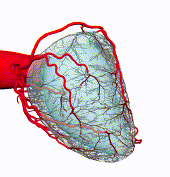
Image-based models derived from CT angiography are being used clinically to simulate blood flow in the coronary arteries of individual patients. However, image resolution limits vessel segmentation to the larger epicardial vessels. To simulate blood flow into the myocardium, generation of smaller vessels is necessary. Constrained Constructive Optimization (CCO) is a single tree generation method based on functional principles which simulates angiogenesis. In this work, we extend CCO to account for multiple, competing vascular trees, emerging from actual vascular tree models segmented from CT images. The generated trees fill the entire left ventricle myocardium down to the size of the arterioles.
From a segmented epicardial coronary model, we distribute tree roots aiming for left ventricle perfusion. Measuring diameters at vessel outlets of the segmented model, we estimate a prescribed inlet flow for each synthetic tree. The tree forest is grown in two stages: first, on the left ventricle epicardial surface, second, inside the whole volume. Following CCO principles, dichotomous trees are generated with equal flow at terminal segments. Multiple tree growth inside a single territory induces a competitive process. Growth speed is proportional to tree inlet flow, ensuring that the prescribed flow value is reached. To correlate with patient priors, new segments are forbidden to cross segmented vessels and must respect physical angular constraints.
We generated networks for 6 patients, with 6000 terminal segments each. The algorithm demonstrates robustness, repeatability and adapts to the patients’ anatomies. The model geometry satisfies continuity between the segmented and generated vessels, and correlates well with morphometry properties previously described.
This patient specific vascular model satisfies literature morphometry. The generated hybrid models can be used to simulate blood flow and derived quantities from the aorta into the myocardium. This is an important step for the diagnosis and treatment planning of coronary artery disease.

